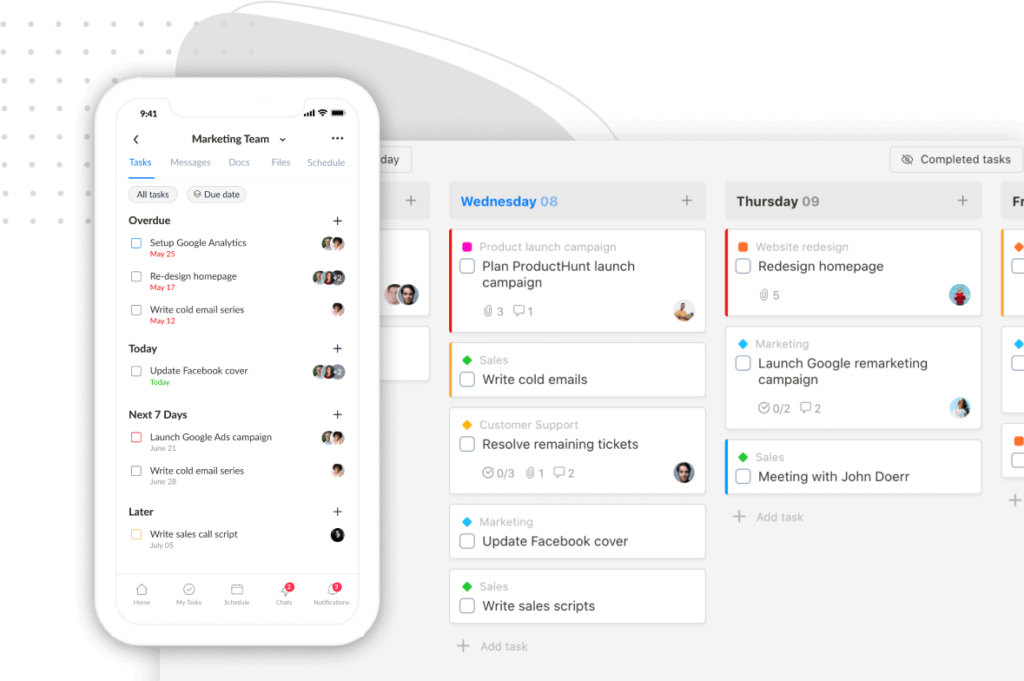If you are considering whether to invest in Workfront, answer these two questions:
1. Would you like to pay a bunch for a project management tool with no free trial, takes weeks for the initial setup, requires lots of time for onboarding, has a clunky interface, and is clicky to navigate?
This platform helps your teams collaborate seamlessly in one place without switching back and forth between multiple apps.
2. What if you could have an alternative with similar team collaboration functionality while compensating for all the shortcomings of the above platform? Will you make a switch?
In this article, we will give you the most promising Workfront alternatives. We’re sure that you’ll like it. So, let’s get to it!
Why look for Workfront alternatives?
While Adobe Workfront is considered one of the major players in the work management industry, it still has some cons:
Steep learning curve
With the vast features and customization options, Workfront has a steep learning curve, resulting in difficult onboarding. On G2, Capterra, or other software review websites, it’s easy to find a lot of complaints about this.
To fully master all the functionality of Workfront, you’ll need to spend tons of time or never.
Initial setup is time-consuming
First-time setup can be very time-consuming, especially if heavy customization is required for your business. The rich customization of Workfront could take weeks to complete the setup process.
Clicky navigation
Finding a task in Workfront that you don’t know which project it is associated with can be confusing because the software is very clicky and difficult to navigate.
Not saying that pages sometimes display current projects in different ways.
Not user-friendly UI
While Workfront is powerful and scalable, its layout is not intuitive – which becomes a hindrance for small businesses and brand new users.
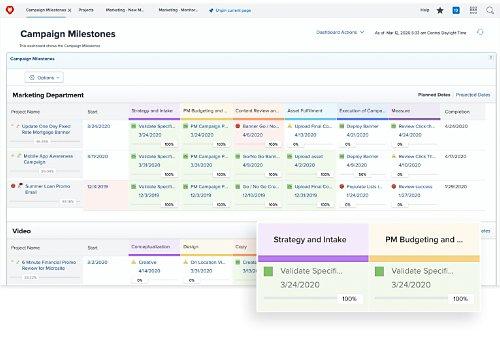
But you know what, even users who have been utilizing the platform for 1+ year still admit that they are sometimes confused about how to do several actions.
Lack of clarity in pricing
While almost all project management platforms show their paid plans on the website, Workfront doesn’t. If you want to learn more about their pricing, you must request a quote.
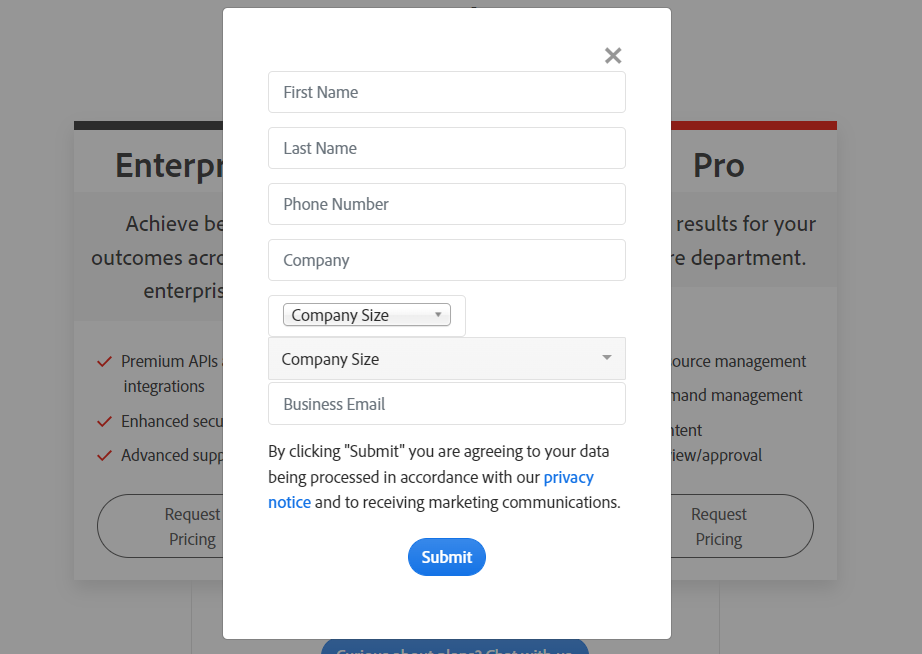
The second minus point is you’ll have to wait to be contacted by their sales team before you can set it up.
After all, is it worth it?
No free plan or free trial
There’s no free plan or free trial for Workfront. Want to use the platform? Show your money.
According to our search, Workfront charges $30 per user per month for a basic feature package. And the price will go up if your team grows.
14 best Workfront alternatives for project management in 2025
1. Upbase
If you are looking for a simple solution, you might consider Upbase, an all-in-one work management platform specifically developed for small businesses to stay in tune.
Wondering how Upbase is better than Workfront? Let’s find out!
Key features
Simplicity
Upbase shows pride in its simplicity, and for good reason.
Not many comprehensive project management tools out there can neutralize functionality and simplicity.
The most common issues are cluttered interfaces, difficult onboarding, a steep learning curve, and clicky navigation, which badly hurt the team’s productivity. But Upbase is a different story.
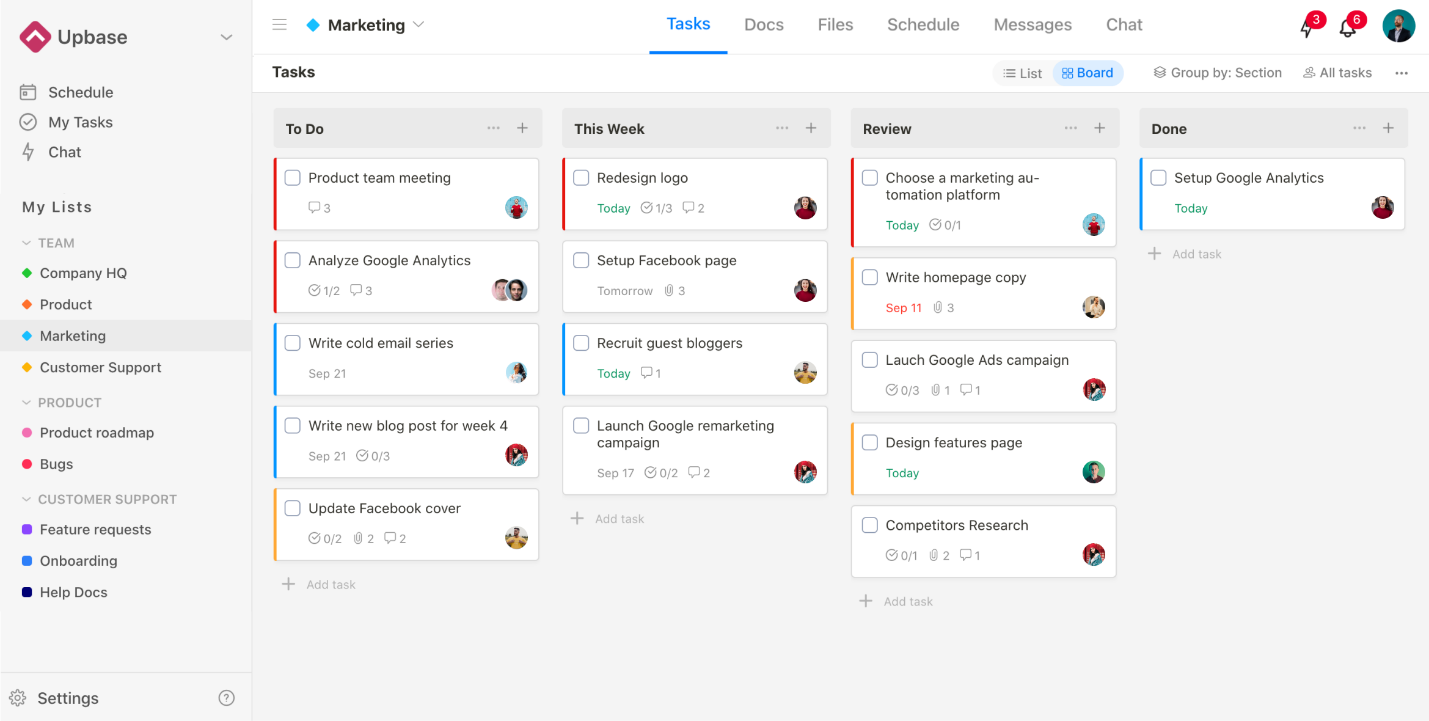
Many hidden features and dropdown menus keep its interface clean and intuitive.
As a result, you can stay away from unnecessary distractions and focus better on work. Upbase’s simplicity makes it easy to navigate, which helps move work faster.
Organized hierarchies
Unlike many other simple project management tools out there, Upbase has an organized hierarchy: Workspaces – Folders/Lists – Sections – Tasks – Subtasks
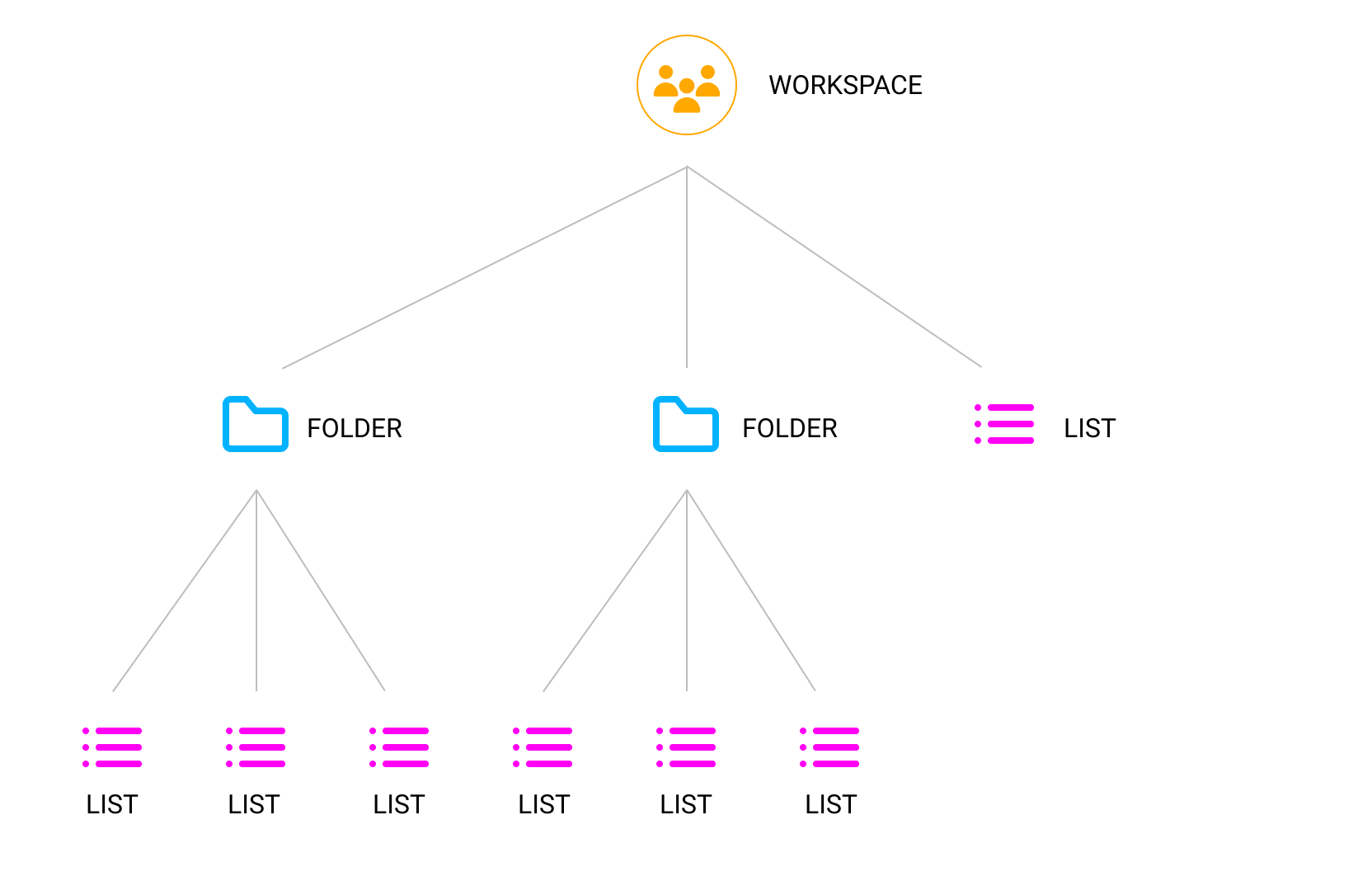
So, while keeping a clean and straightforward interface, Upbase can still break down large-scope projects into smaller pieces, then organize them beautifully. As a result, the app isn’t prone to clutter.
In addition, there are a lot of list icons and colors to choose from, making it easy to organize and classify multiple projects, from basic to complex.
Rich and powerful task management features
Priorities: Let you know which tasks are more important than others to organize your time reasonably and finish your work on time
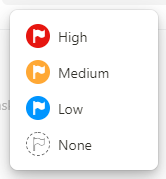
Multiple assignees: Project managers or team leaders can assign multiple team members to a list
Watchers: Any team member added to the watcher list of a task/subtask will receive notifications about every change and update of that task/subtask.
Activity log: A record of all the changes and updates made to a task
Comprehensive collaboration tools
Message board
An online discussion area where all team members discuss topics, post announcements, brainstorm ideas, and give birthday wishes.
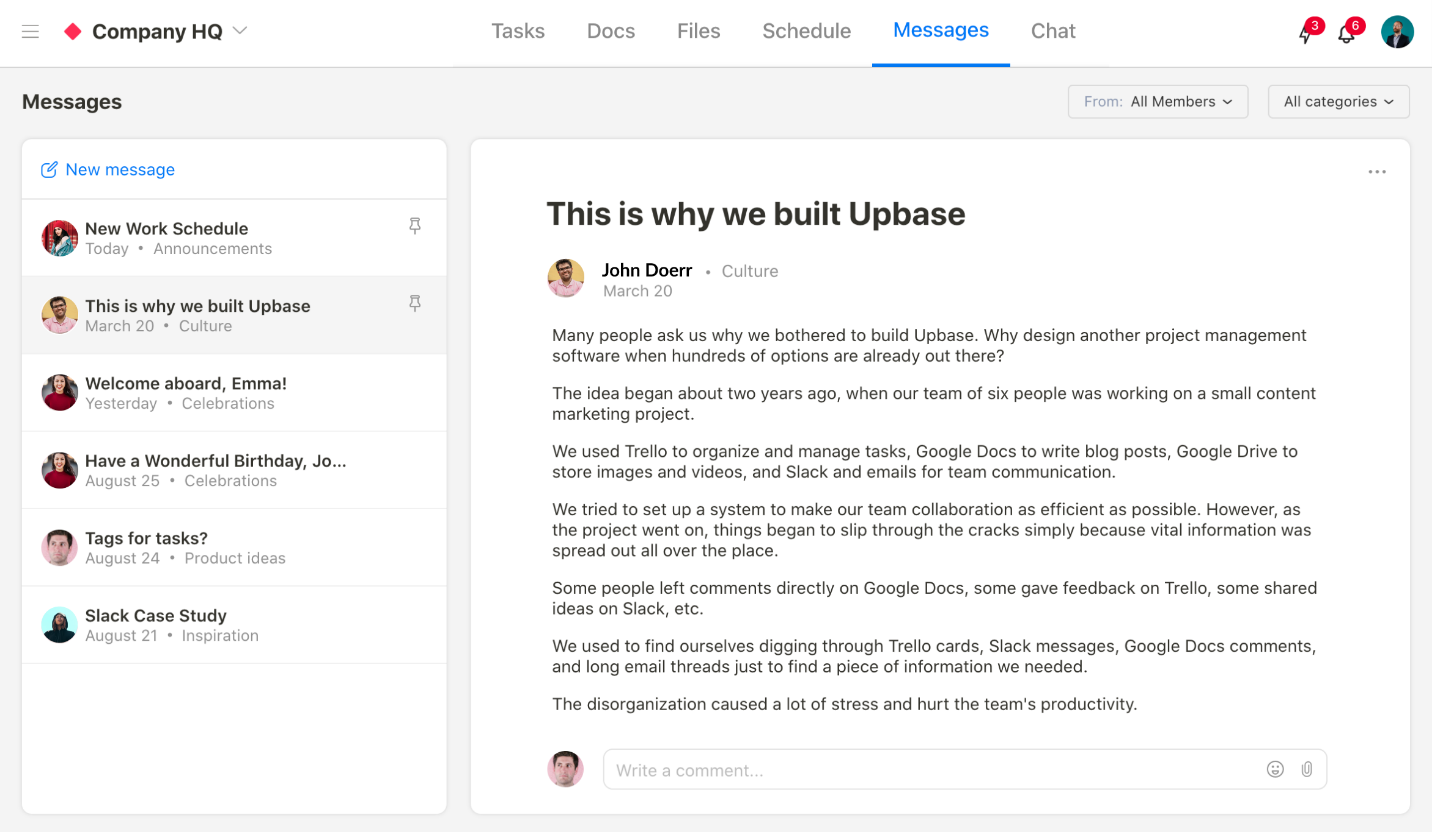
Schedule
Help to schedule all work, assign the right members to the right tasks, and ensure all the projects run as planned. Upbase’s Schedule functions as a monthly calendar or a weekly planner.
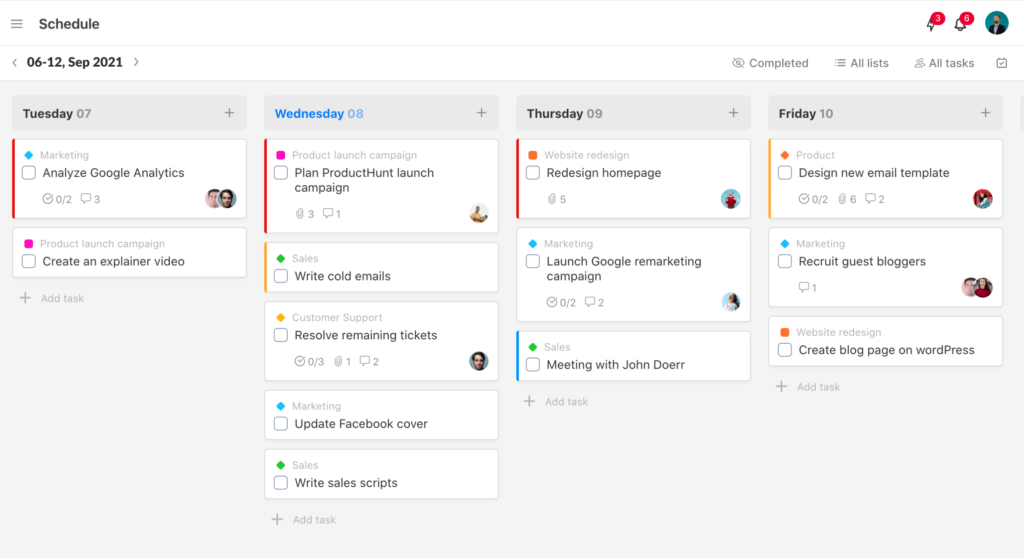
Files
Allow team members to upload, store, and share files. Here is what you also can do in ClickUp’s Files:
- Create folders to organize files
- Two view modes: List and Grid
- Add watchers
- Upload a new version
- View file versions
- Share a file’s public link
- Comment
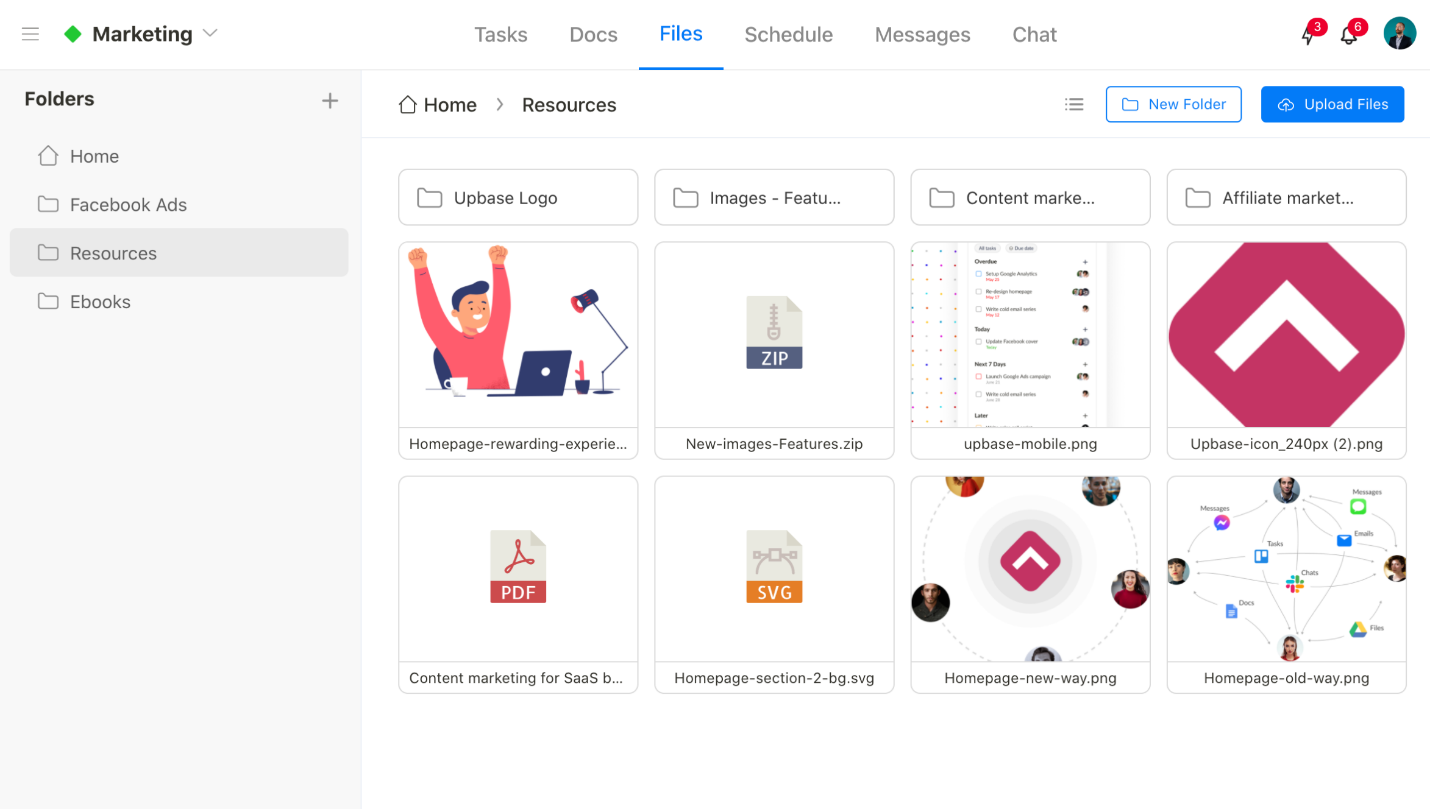
Docs
This is where team members can create knowledge bases, notes, and wikis. To help organize documents, Upbase’s Docs offer folders and five levels of subfolders.
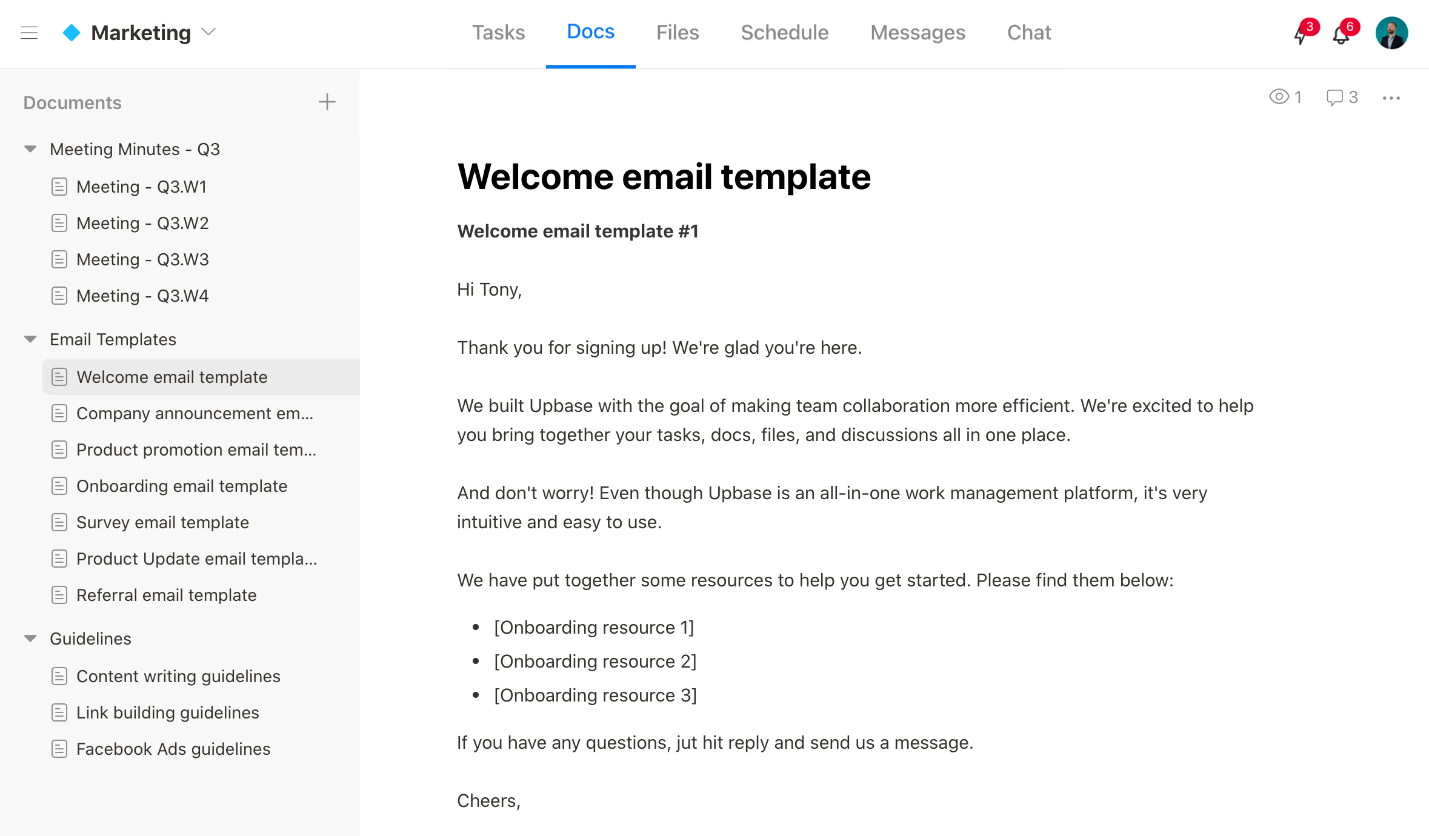
Chat
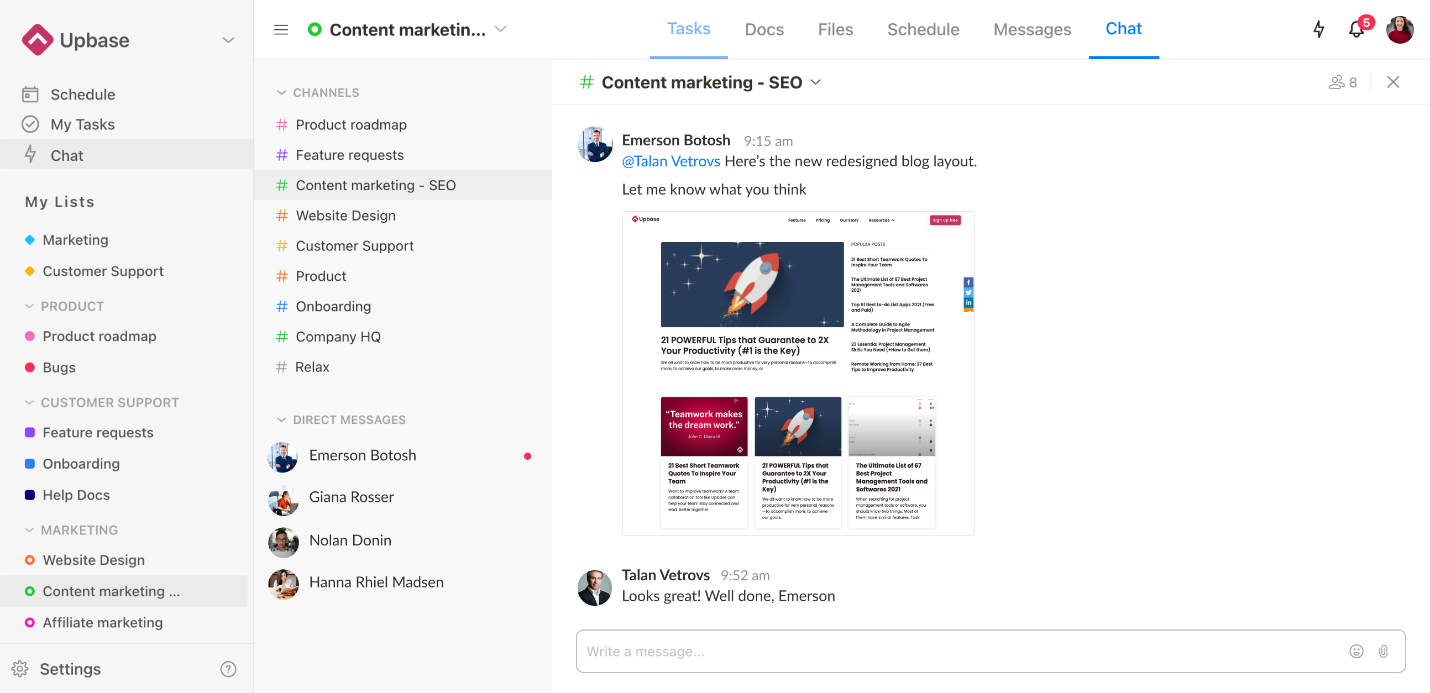
With Upbase’s Global Chat, you can create:
1:1 chats – Send direct messages to a team member. In the picture, 1:1 chats are in the “Direct Messages” section.
Customizable group chats (Custom Channels): Create a group chat where you can freely add/remove any members within the workspace.
Group chats are automatically created upon the projects (List Chats): When you create a new List, a corresponding group chat is created, named after the list, and includes all the members within the list.
Another difference between Custom Channels and List Chats is the color of “#”. Custom Channels are always in gray, while List Chats are in the same color as their Lists.
So, in the above picture, in the “Channels” section, “#Relax” is a custom channel while the rest are list chats.
Members Page
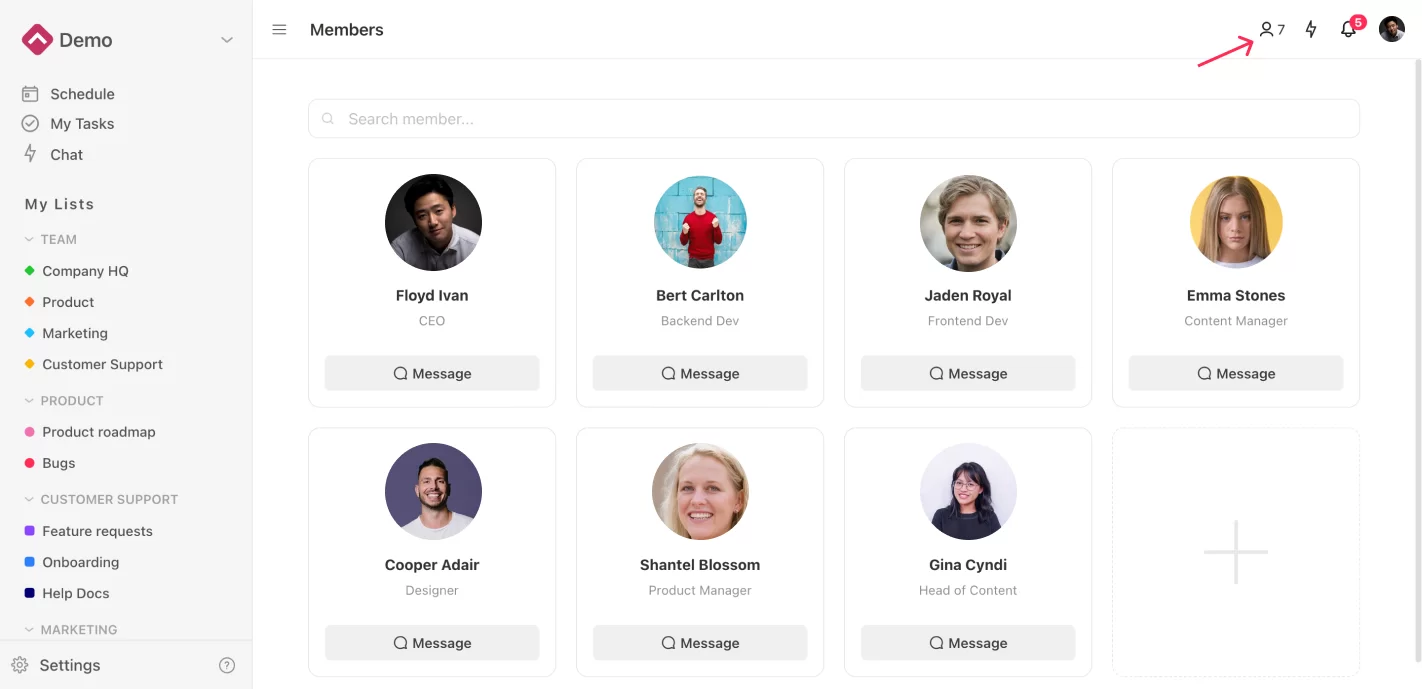
Help project managers or team leaders monitor which and how many tasks are assigned to each member. From there, they can find a better way to distribute work and optimize the team’s productivity while preventing burnout.
Why is Upbase the best alternative to Teamwork?
- A low learning curve
- Very generous free plan
- Quick and easy to set up
- Simple, user-friendly UI
- An all-in-one work management tool
- Affordable for small businesses
Limitations
- No Gantt chart
Pricing
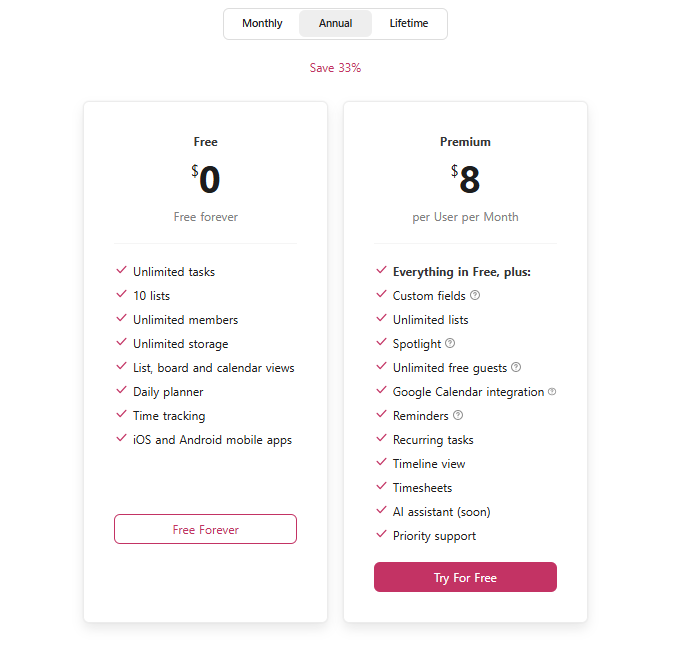
Upbase offers one of the most generous free plans on the market, featuring unlimited tasks, members, and storage at no cost. Why settle for less when you can have it all for free? Sign up for Upbase today.
2. Smartsheet
Smartsheet is a modern collaboration and works management software solution for multinational corporations, large businesses, and enterprises. The name says it all, Smartsheet functions like a super-sized spreadsheet, but is more powerful and customizable.
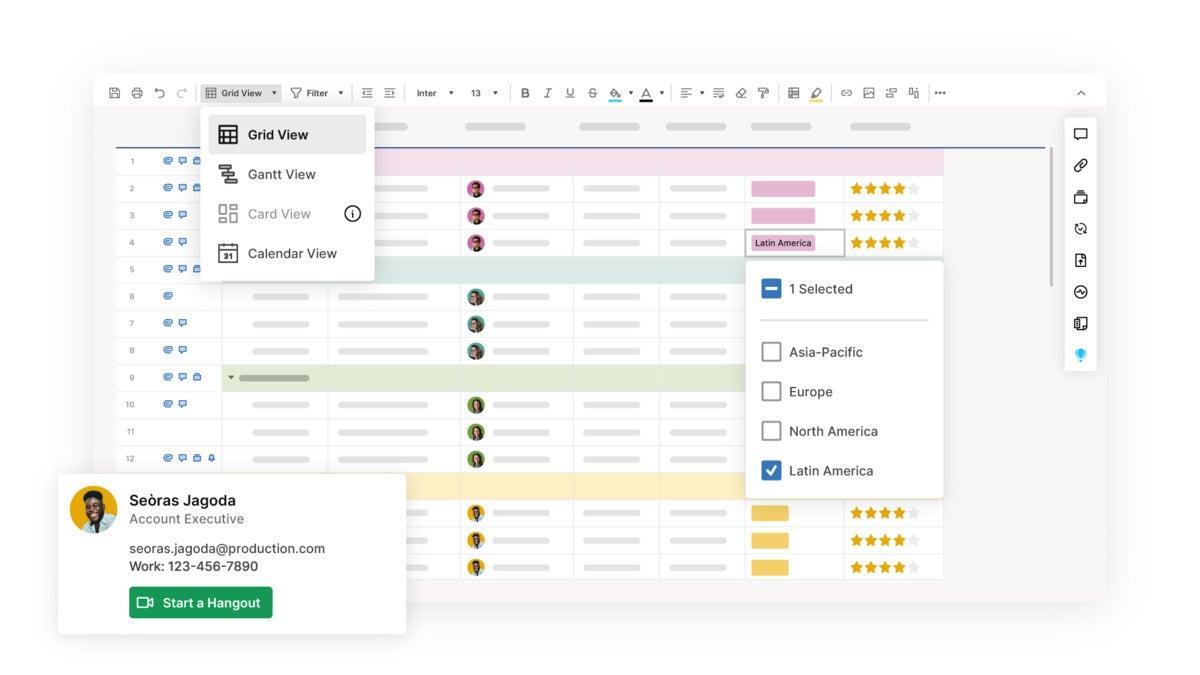
For deadline tracking, task assigning, and customized workflow management, Smartsheet gets the job done beautifully.
One of the few things we complained about was limited customization options on the Card view in terms of visual aspects. Smartsheet also has a high learning curve, which means any brand new user must invest the time to get the hang of it.
Key Features
- File-sharing
- Multiple permission levels
- Alerts and reminders
- Advanced reports
- Calendar, Gantt, Card, and Grid views
Pros
- Easier to customize and more flexible than Workfront
- Provide a 30-day free trial
- Easy to automate workflows
- Very powerful to support seamless collaboration in one place
Cons
- A high learning curve
- Limited card customization options
- It might not be friendly for some people
Pricing

3. Airtable
Airtable is a low-code cloud collaboration software built to help users customize their workflows, manage work, track tasks, and more.
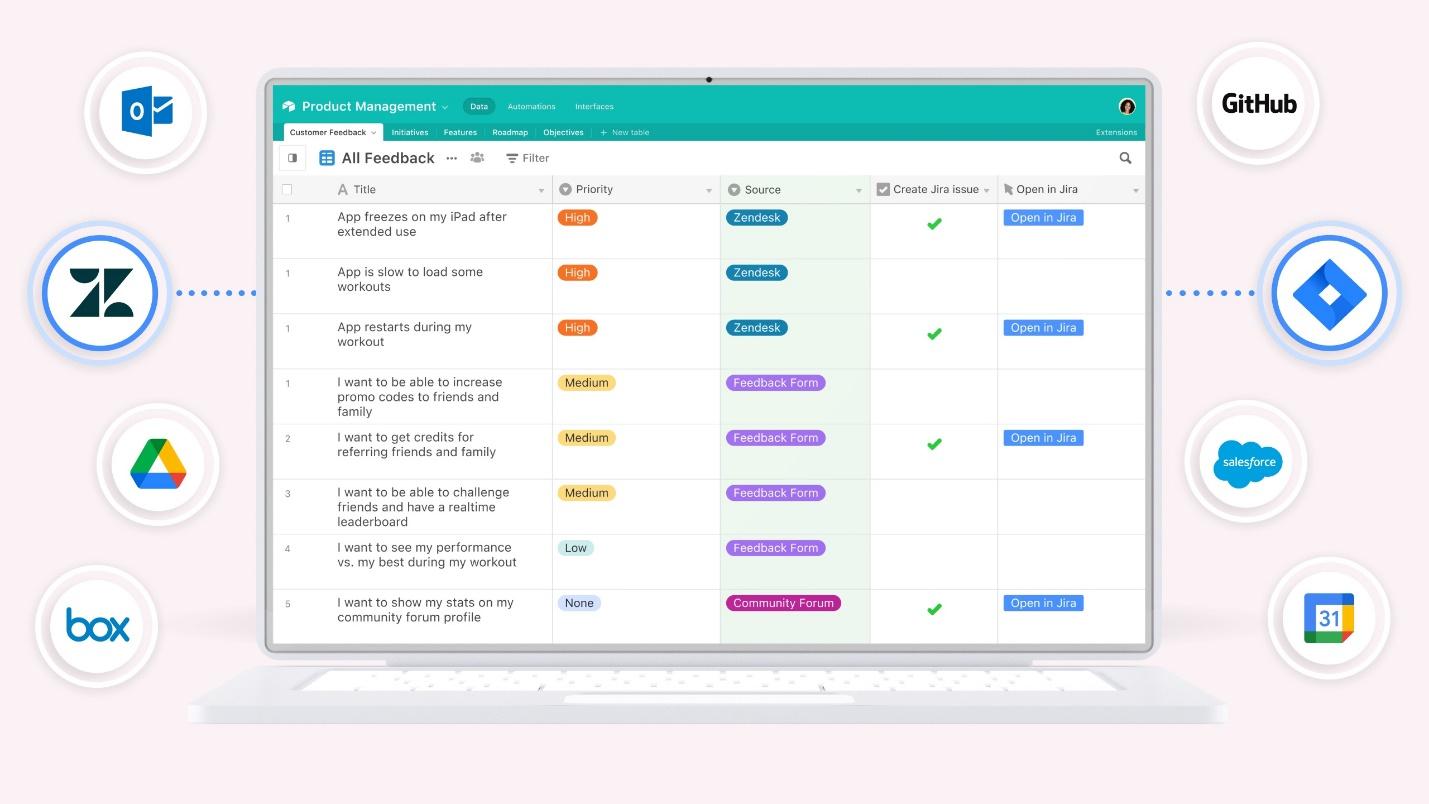
Like Smartsheet, this tool emphasizes a spreadsheet-style interface but provides more customization options for more adequately serving businesses than Google Spreadsheets or Microsoft Excel.
So, what’s the difference between Smartsheet and Airtable?
Airtable is more customizable to meet the workflow of different teams, while Smartsheet packs more advanced features for project management.
Key Features
- Calendars
- Automatic notifications
- Customized views
- Customized fields
- Upload spreadsheet
Pros
- High adaptability to all kinds of businesses
- Visually appealing user interface
- More affordable than Workfront & offer a free trial
Cons
- Limited permission levels
- A learning curve
Pricing

4. Wrike
Wrike is an enterprise-level work management tool that packs various powerful features such as workflow statuses, Gantt charts, file-sharing, and a time tracker.
But what sets Write apart is its detailed analytics and insights that help you calculate deliverables and let you know if your project is failing.
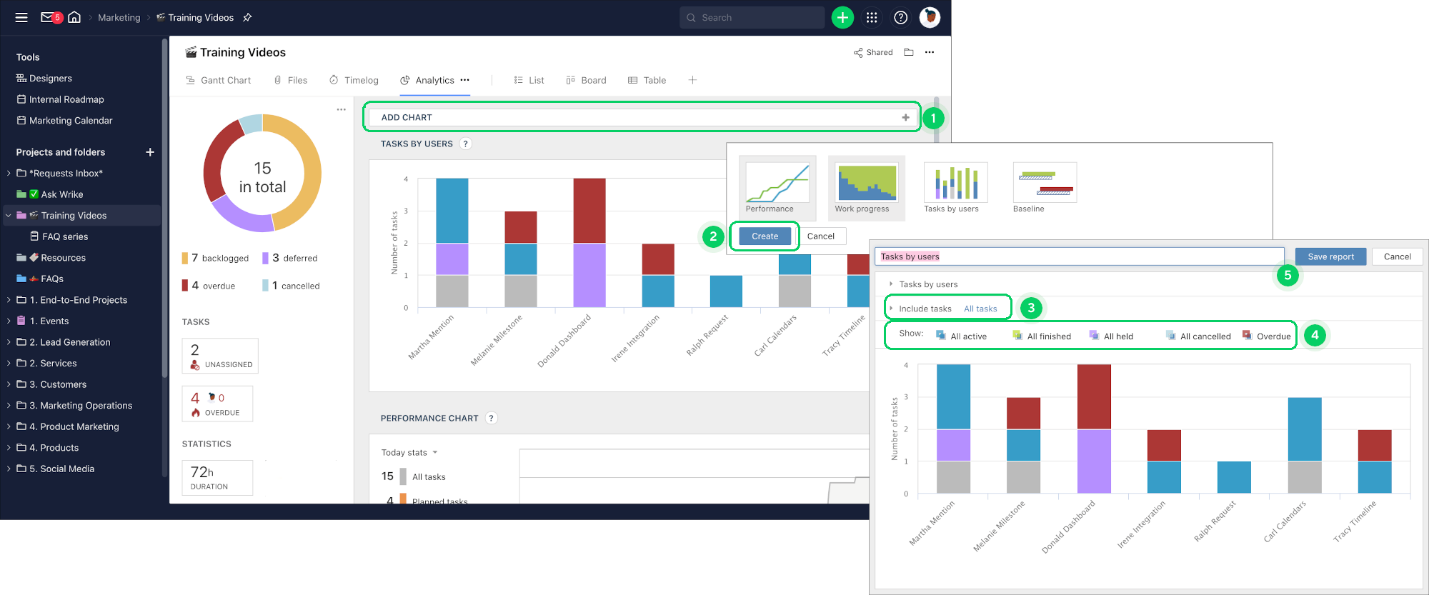
Unlike Adobe Workfront, this project management tool can be tailored to fit different sizes and kinds of teams.
However, small businesses probably should consider other Workfront alternatives, especially if you’re on a tight budget because Wrike’s paid plans are expensive.
Key Features
- Detailed analytics and insights
- File-sharing
- Workflow statuses
- Wrike Proof tool
- Gantt charts & Kanban boards
Pros
- Easy to tailor to different departments or unique company needs
- Give you intensive insights into your tasks and projects
- Easy to find a task within the workspace
- Allow teams to collaborate on the shared files
Cons
- Not easy to learn
- Quite expensive
- Difficult to navigate
Pricing

5. Zoho Projects
Zoho Projects is a cloud-based project management tool for small to mid-sized businesses.
Unlike Adobe Workfront, Zoho Projects has a built-in chat system for easy in-app communication.
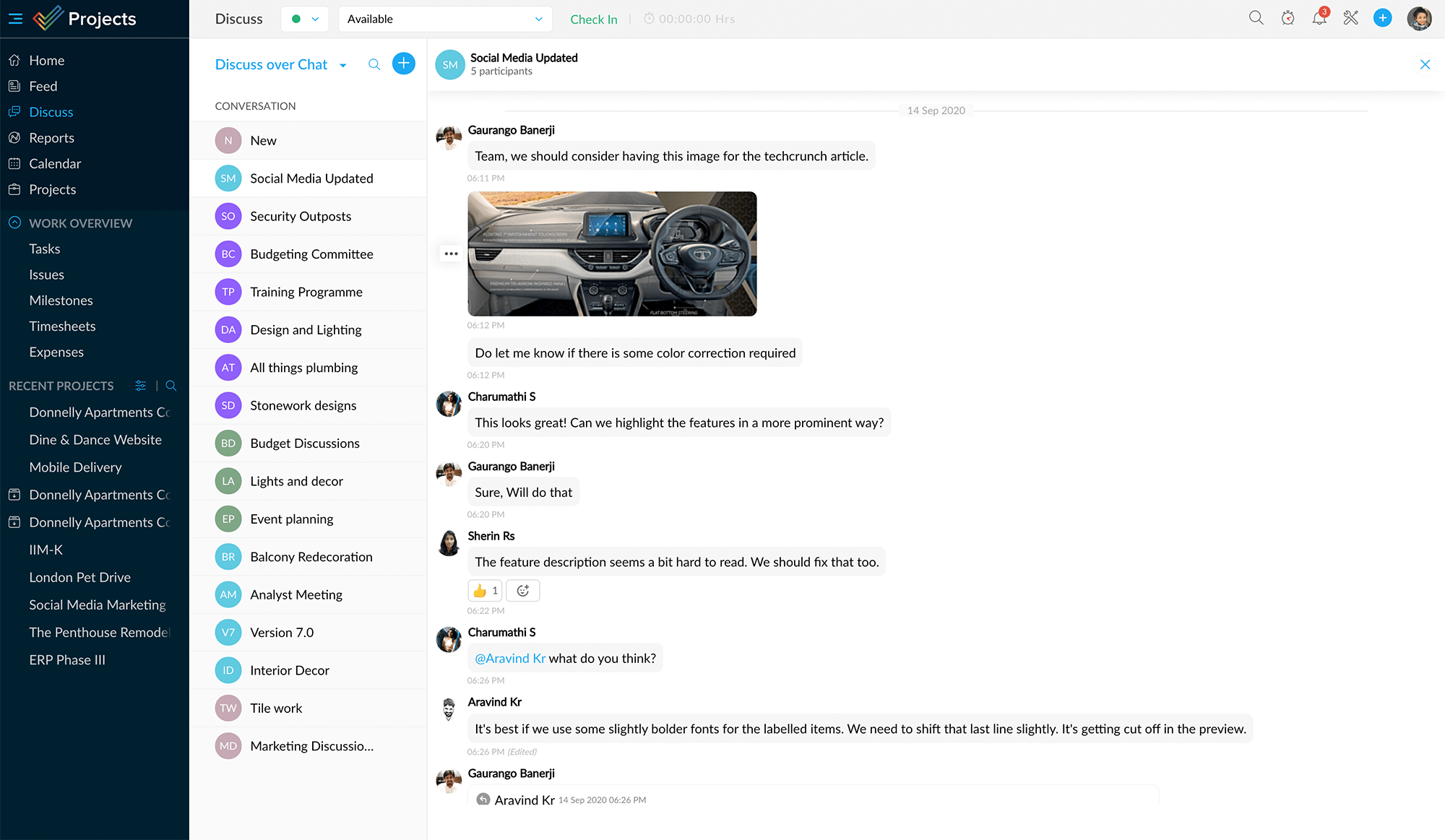
Compared to other project management software solutions, Zoho Projects provide more features to help teams collaborate, track work and plan their projects more efficiently.
All that said, Zoho isn’t pleasant to use. With too much customization combined with clunky UI, the tool has a steep learning curve and could overwhelm new users.
Key Features
- File-sharing
- Forums and chat function
- Advanced analytics tools
- Gantt chart view
- Issue tracking and timesheet module features
Pros
- Easy to navigate
- More affordable than Workfront
- Easy in-app communication
Cons
- Limited automated features
- Poor UI
Pricing

6. Teamwork
Teamwork is a complete project management software solution dedicatedly built for client work. As such, your clients can join Teamwork and collaborate, which is much more effortless than keeping it internal, then sending emails to clients and reminding them of the job you are referring to.
As a result, Teamwork helps enhance your productivity in this digital world.
While the software can bring everything relevant to a project together in one place, it lacks a built-in chat tool.
Compared to other Workfront alternatives with file-sharing functionality, Teamwork’s 2GB file storage is too limited to handle complex projects.
Key Features
- Scheduling
- Automated workflow features
- Gantt charts & Board view
- Messages
- Time tracking
Pros
- Easy to navigate
- Prevent team members from burnout
- Effortlessly collaborate with clients
- Give you a complete perspective of your work
Cons
- No real-time chat tool
- Probably expensive for small businesses
- Limited file storage
Pricing
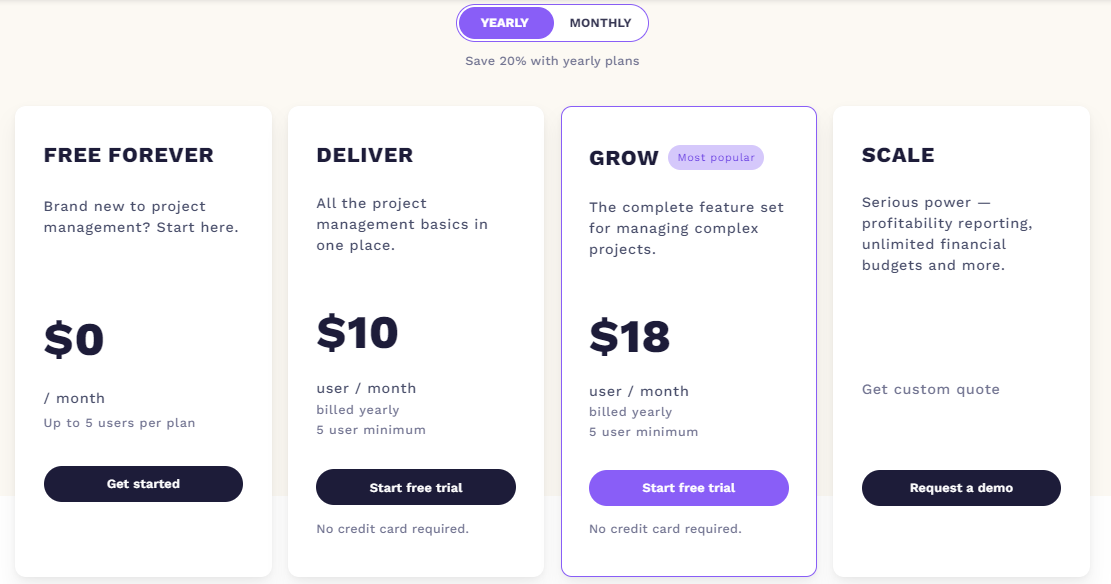
7. Asana
Asana is not a complete project management tool like Teamwork because it does not support budgeting, resource management, or expense tracking. However, it’s super-flexible.
Asana can assist small to mid-sized teams to efficiently manage their tasks and projects, and customize workflows. It also eagerly rolls out new features such as workflow builder, changes to tasks, calendar integration, etc. – so productivity enthusiasts love it.
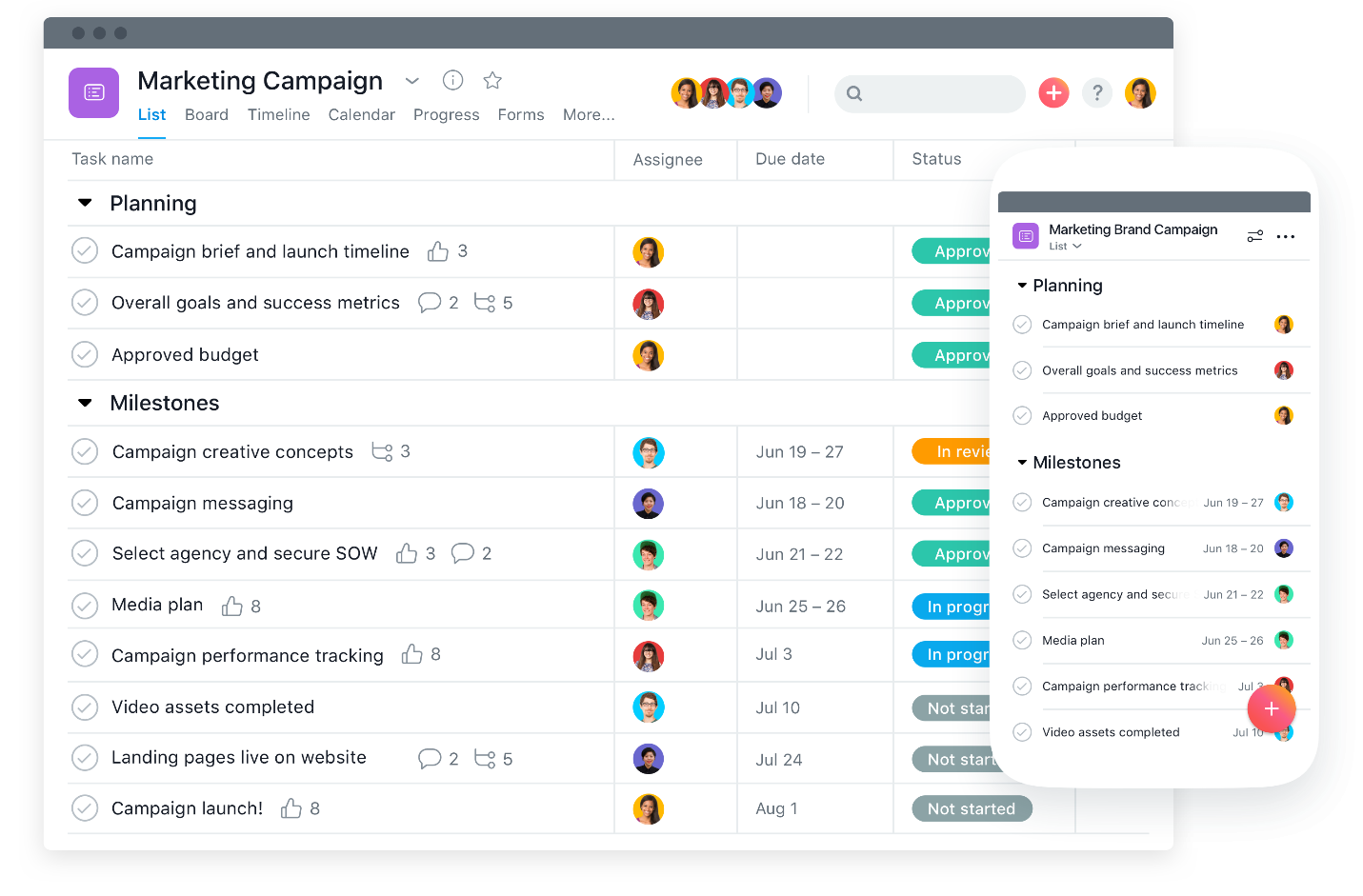
While Asana’s paid plans are costly compared to other project management software solutions, it’s far more affordable than Workfront. In addition, it offers a forever-free plan.
Key Features
- Messages
- Custom fields
- Assignees & due dates
- Project Overview
- Time tracker
Pros
- Offer a forever-free plant
- Super-flexible with great speed
- Able to see the big picture of what to accomplish
Cons
- A bit challenging to register
- Clunky UI
Pricing

8. Basecamp
As a communication and collaboration tool, Basecamp does the job excellently.
Though Basecamp doesn’t pack as many features as Adobe Workfront, the tool is simple to set up, intuitive, and easy to navigate. It also offers better pricing.
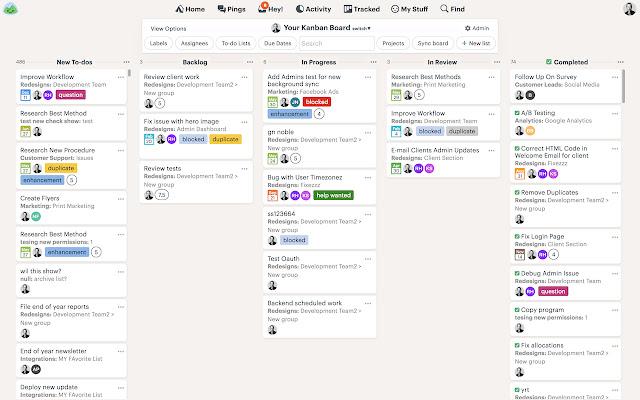
The biggest strength of Basecamp is that it promotes effective communication between team members, with clients, or across all departments. As a result, the tool helps teams require fewer meetings and be more productive than ever.
Key Features
- Calendars
- Docs & files
- Message board
- Real-time chat
- Automatic check-ins
Pros
- Quick to set up & easy to navigate
- A lot more affordable than Adobe Workfront
- Enhance team communication
Cons
- Basecamp’s Files tool is largely inefficient
- Lack subtasks
Pricing
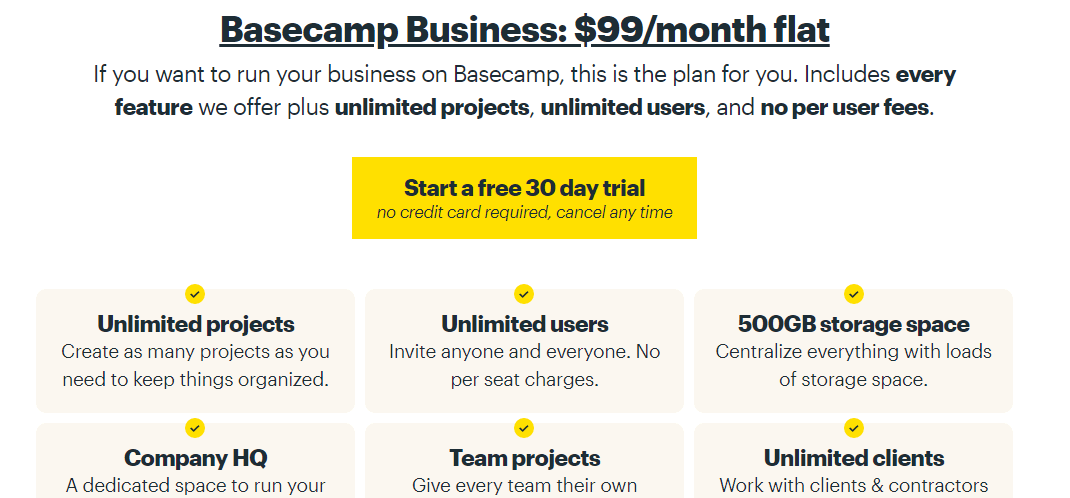
9. ClickUp
ClickUp is a comprehensive project management software solution that offers 100+ features for free. It also offers endless customization to suit any business or personal purpose nicely. The pricing of ClickUp is affordable, too.
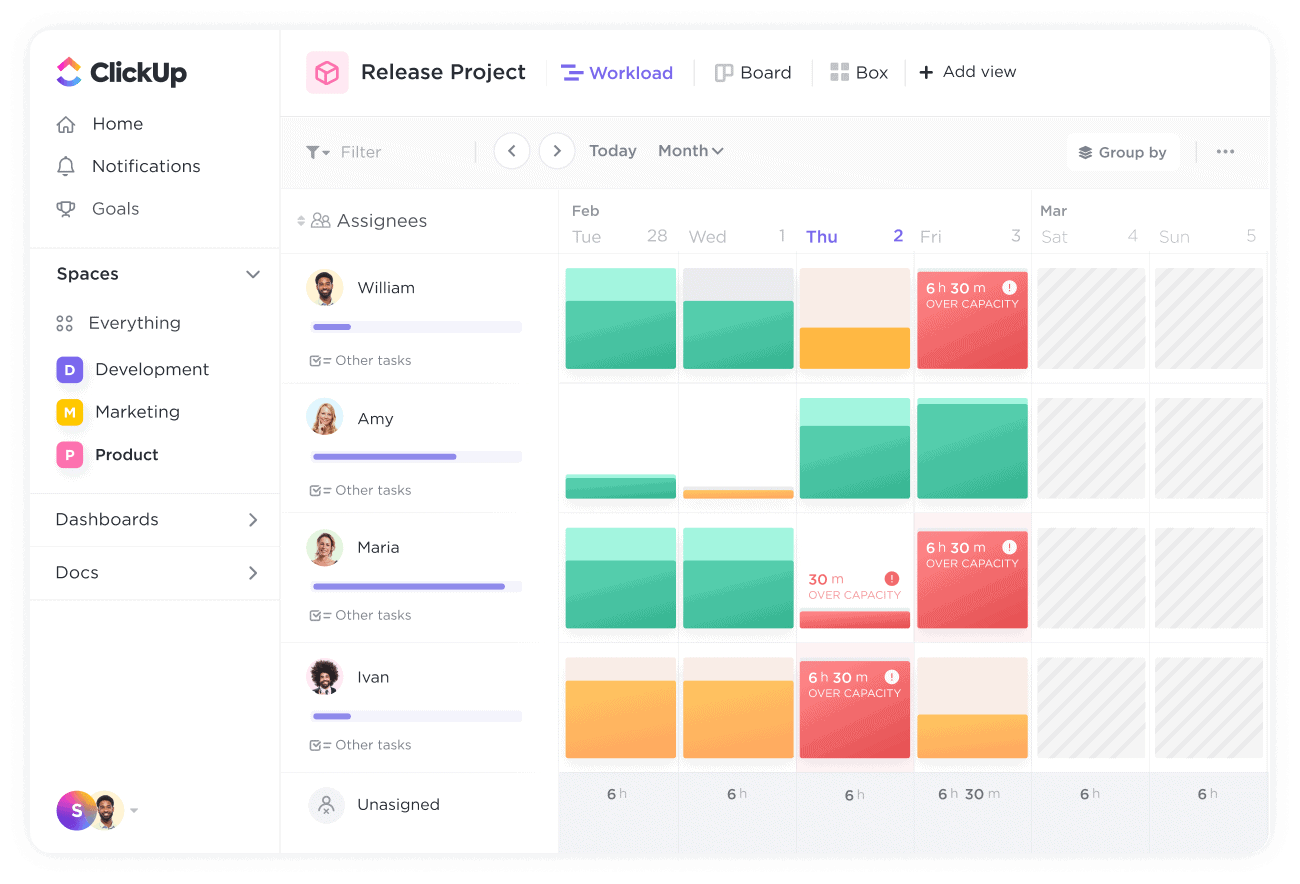
But, with so many features and customization options, ClickUp has a learning curve and could be overwhelming for brand new users.
Besides, as ClickUp offers many different ways to do the same thing, it could distract users and cause optimizing anxiety. Its clunky UI is another minus point.
Key Features
- Custom fields
- Task automation
- Nested subtasks & checklists
- ClickUp Docs
- Everything view
Pros
- Highly customizable and flexible to suit all team sizes and types
- Offer a free version for personal and work use
- Support agile teams
- Help to control times during the operation of the projects
Cons
- Overwhelming for new users
- Cluttered interface
- Limited attachment storage for the free version
Pricing

10. Monday.com
Monday.com is a cloud-based project management tool that offers a collection of spreadsheets with customization to help users:
- Follow up on their personal and team tasks
- Better organize their agenda
- Manage time more effectively
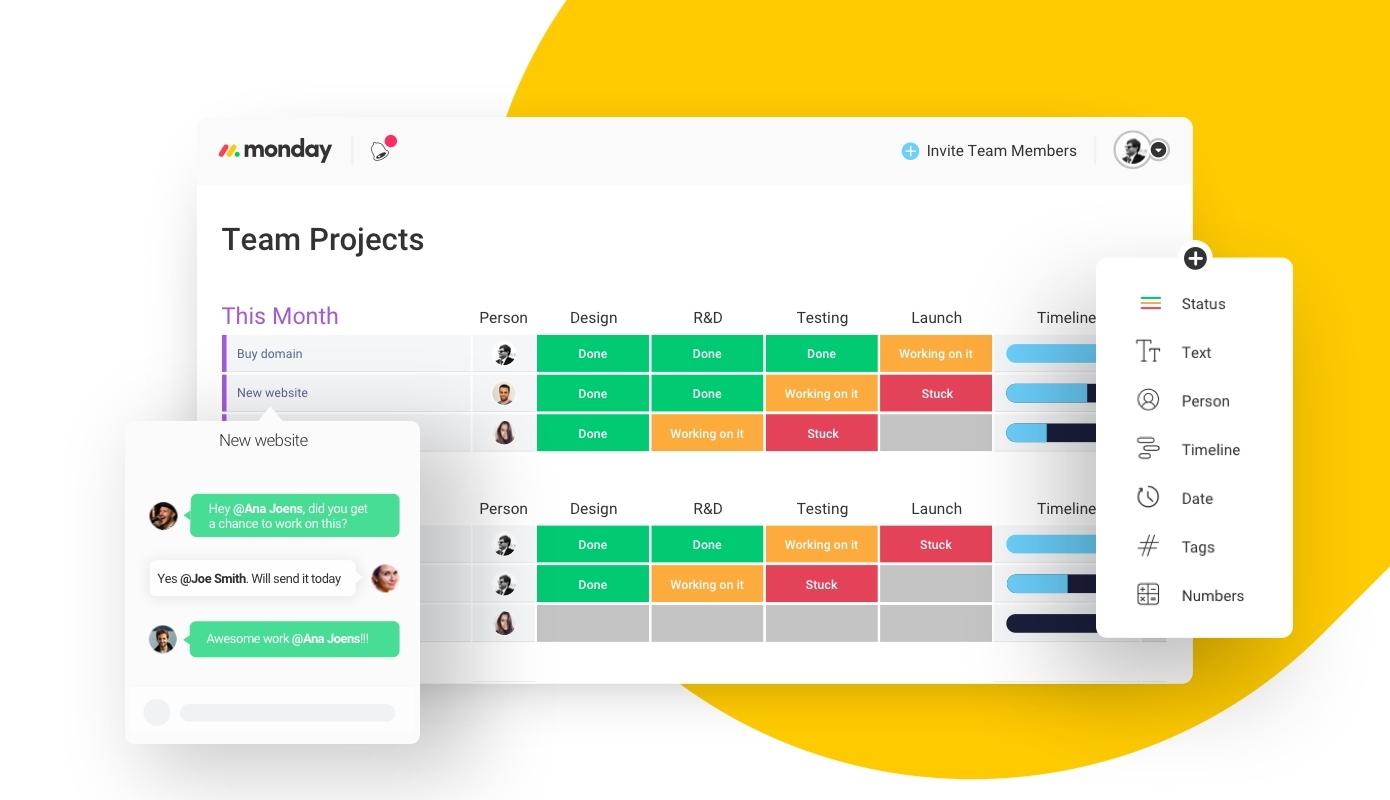
Workfront and Monday.com are both great tools. But if you are looking for affordability, clarity in pricing, intuitiveness, and ease of use, Monday.com is the better choice.
Key Features
- Docs
- Automation
- Dashboards
- Boards
Pros
- Keep multiple tasks and projects on track
- Support multiple areas that you need to control
- Great UI/UX
- Offer a free account option
Cons
- Not easy to learn
- The initial setup can be confusing
- Sometimes, the server is too heavy
Pricing

11. Trello
If you are a startup business with less than 10 members and just want to keep track of simple projects, then Trello is one of the most promising Workfront alternatives.
This project management tool uses Kanban boards and cards as its foundation, making it highly visual and straightforward, especially for users who lack technical skills to set up and use.
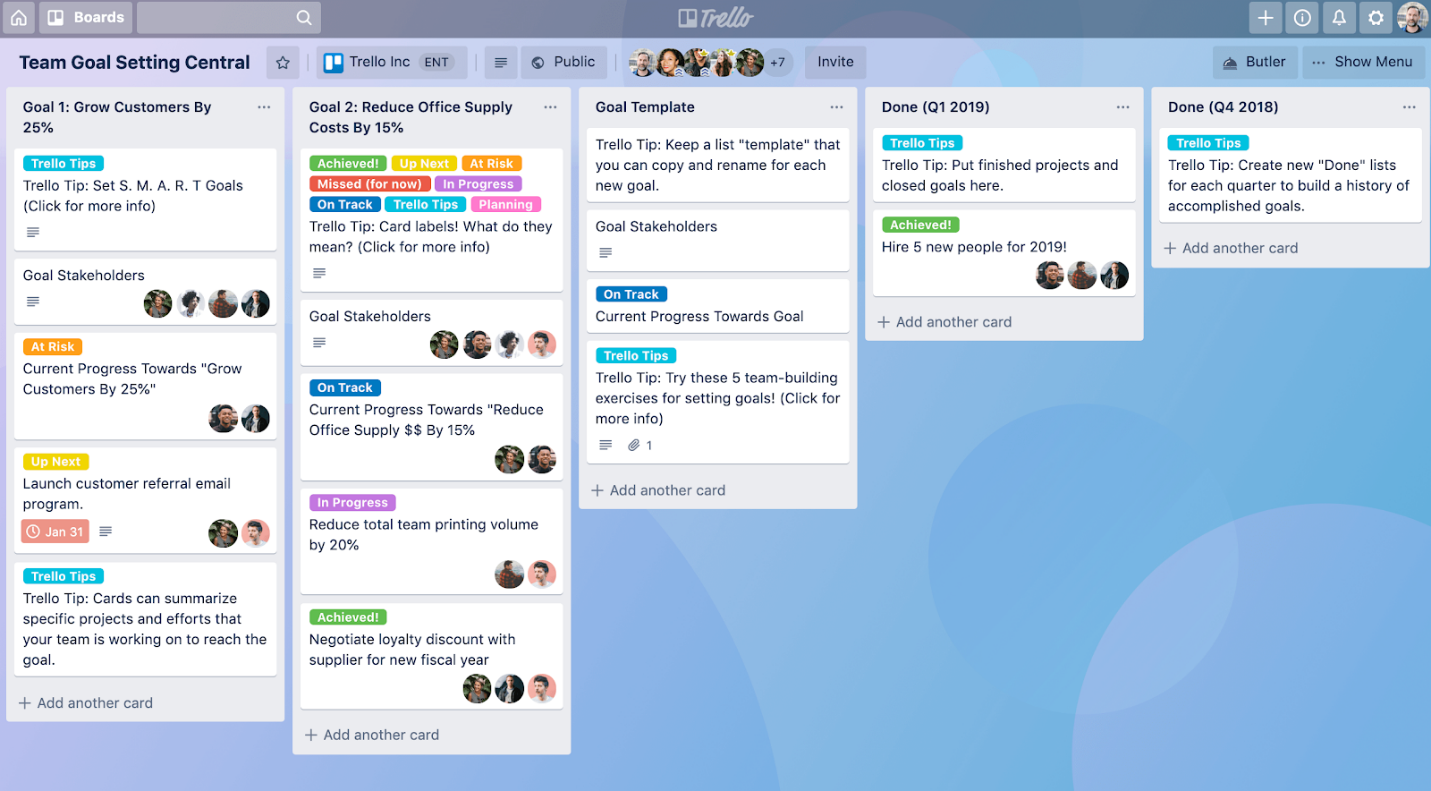
Trello might not be an ideal Workfront alternative for large teams because it lacks many advanced functionalities to tackle complex projects.
Key Features
- Kanban boards
- Lists
- Cards
- Butler
- Power-ups
Pros
- Simple to use
- Easy to visualize task progress
- Help you get more done on admin tasks and save time
- A low learning curve
Cons
- Hard to scale up
- Not manage complex projects effectively
- Power-Ups don’t work well together
Pricing
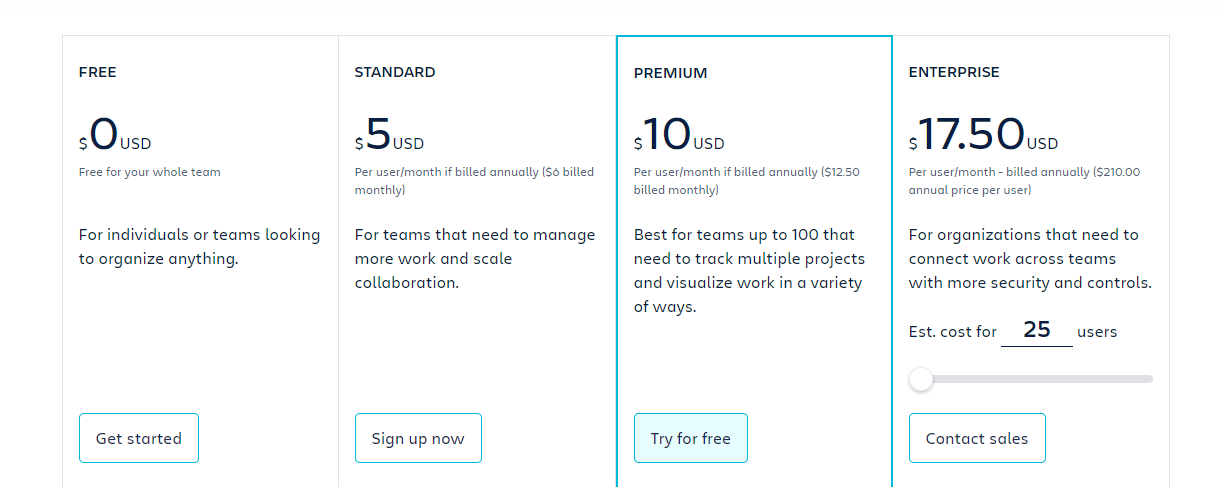
12. Celoxis
Celoxis is a powerful, fully-featured tool for project management, team collaboration, issue tracking, and resource management.
By consolidating the information in one place, Celoxis helps everyone in a team work efficiently and enhances their productivity.
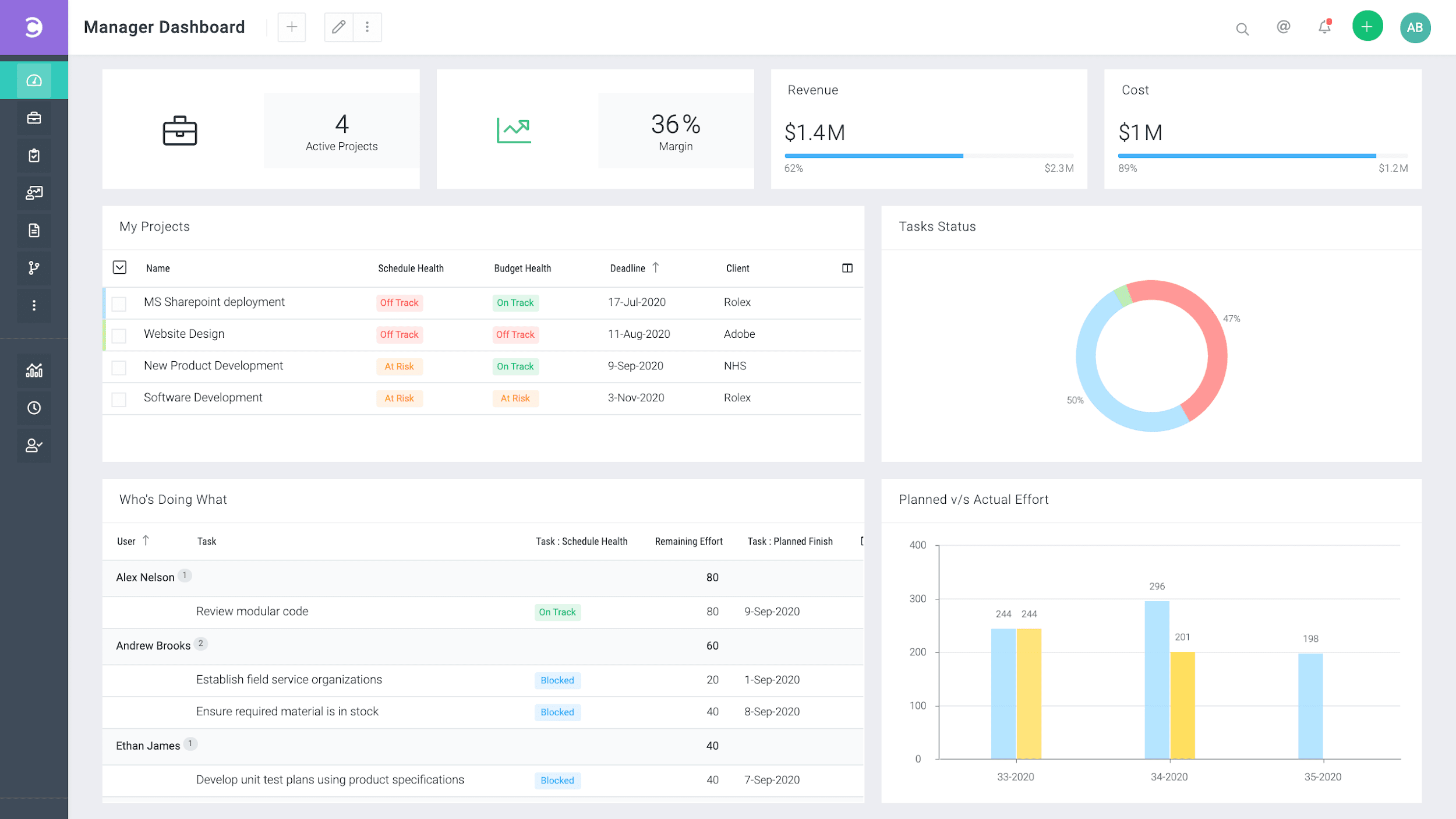
This is one of the most fantastic Workfront alternatives powerful for waterfall project management at affordable prices.
But because Celoxis doesn’t offer any additional agile artifacts, just the Kanban view, we would say this tool isn’t best suited to agile teams.
Key Features
- Task priorities
- Automatic scheduling
- Customizable fields and workflows
- Critical Path Analysis
- Inter-Project dependencies
- Milestones
Pros
- Easy to streamline workflows
- Keep all the important information in one place
- Provide great insights
Cons
- No customizable permissions
- Difficult to learn
Pricing
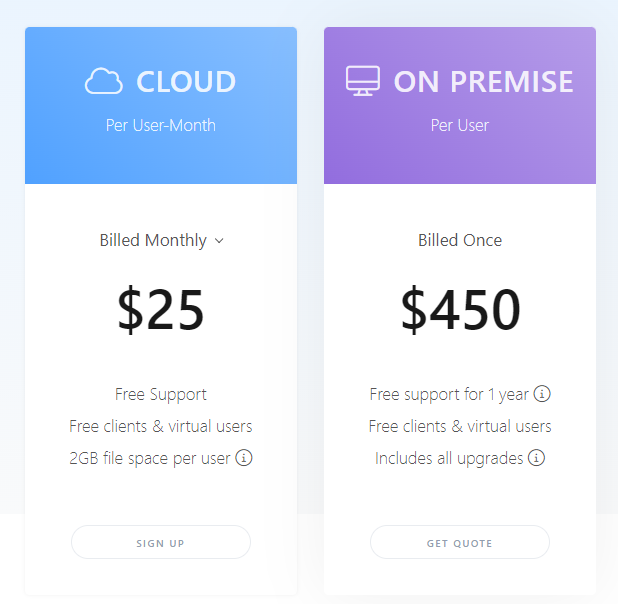
13. nTask
What makes nTasks one of the top picks for Workfront alternatives is its generous feature package for task and project management, intuitive UI, and affordable pricing.
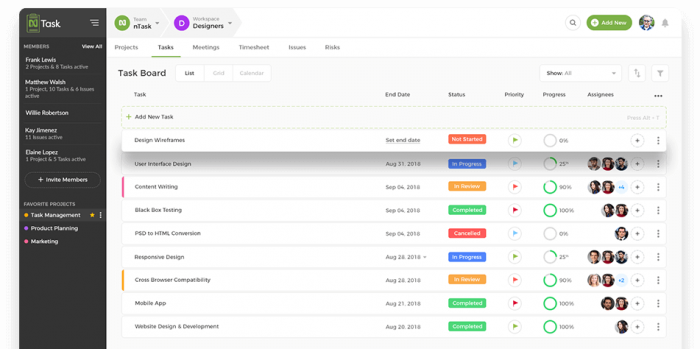
From project tracking and team collaboration to file and document management, nTask helps you handle everything smoothly and easily. Due to the comprehensive features in the free version, nTask can work well as a free project management software solution for small teams.
The downsides? nTask’s interface isn’t user-friendly, and it is difficult to navigate.
Key Features
- Kanban Boards
- Start and due dates
- Custom Roles and Permissions
- Timesheets
- Task deficiencies
- Gantt charts
Pros
- Effortlessly track your team’s time & prevent burnout
- Help you focus on work
- Easy to track all the potential issues that could hurt the team’s productivity
Cons
- Clicky navigation
- Not for large teams
Pricing
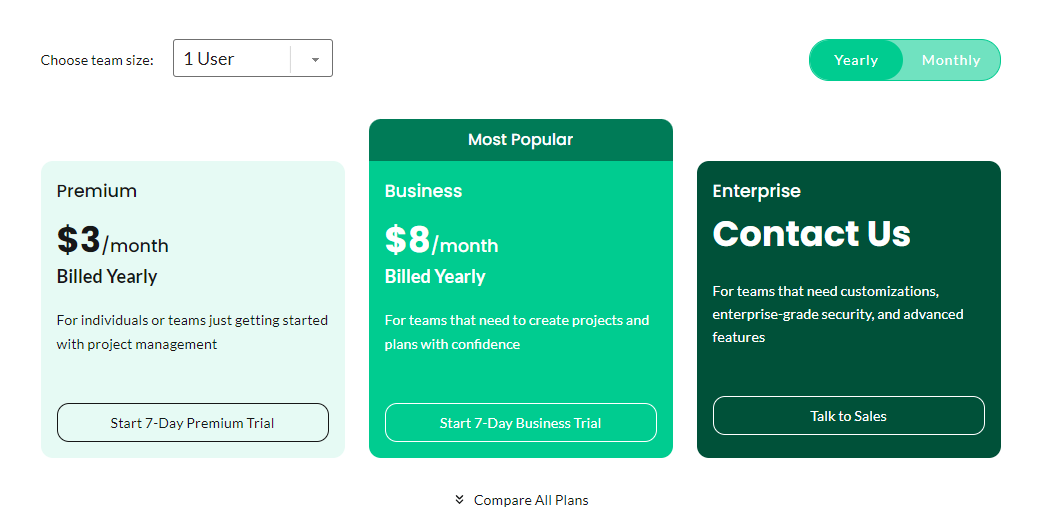
14. ProofHub
ProofHub is one of the best Workfront alternatives that give you efficient ways to manage projects and collaborate.
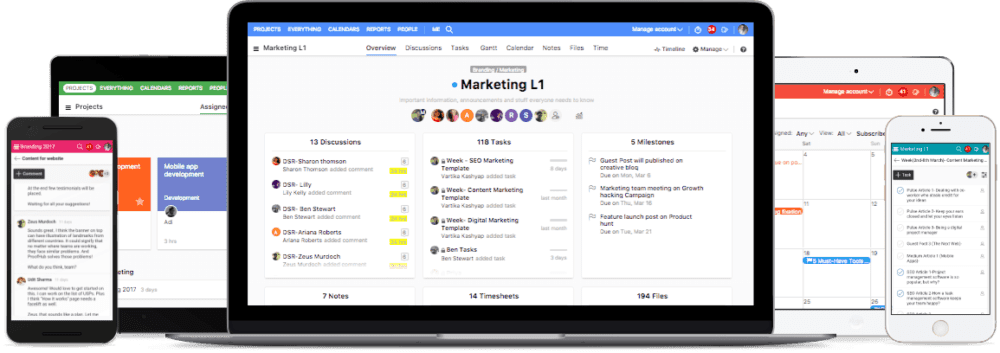
Instead of having to sync multiple tools to get relevant information from other departments, ProofHub offers everything you might need to keep everyone working seamlessly in one place. This way, ProofHub makes your business more manageable, efficient, and organized.
Key Features
- Calendaring
- To-do lists
- Notes
- Discussions
- Gantt charts
- Milestones
- Timesheets
Pros
- Easy to collaborate on the shared files
- Visualize the important information in projects
- Easy to connect with other team members and clients
Cons
- Clunky user interface
- Too many notifications
Pricing
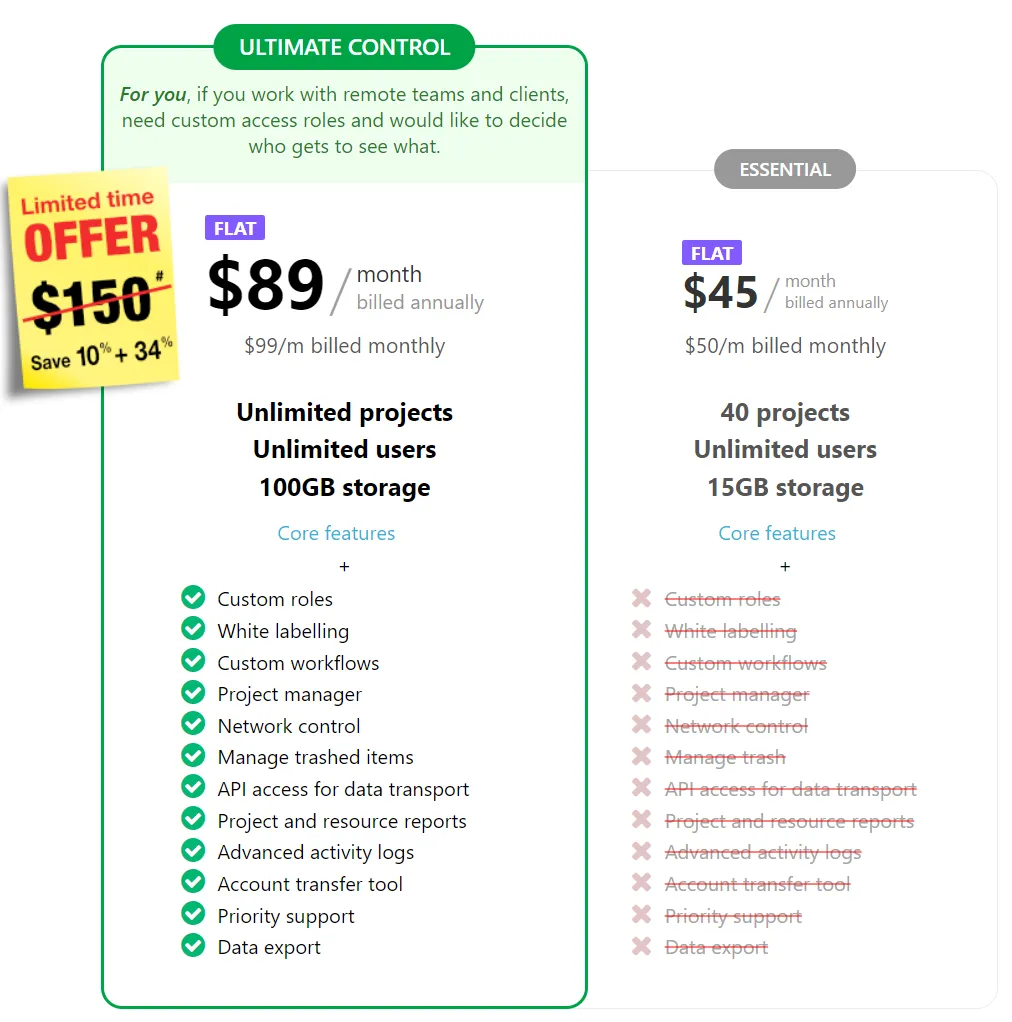
Which of the Workfront alternatives is a good choice for you?
A project management platform aims to help your team track tasks, projects, and schedules efficiently and ensure everyone remains on-task.
Having a project management platform that eats up your precious time from the setup process to the use is useless. And if that’s, unfortunately, your experience with Workfront, don’t hesitate to make a switch.
We hope that with the Workfront alternatives listed above, you will make the decision more easily.
If you want a project management software solution that’s free, simple to use, and can support team collaboration seamlessly in one place, our recommendation is Upbase.
Unlike Workfront, signing up for an Upbase account is free. So, why not try it now?
